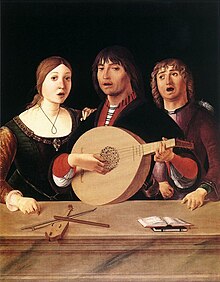Our website is made possible by displaying online advertisements to our visitors.
Please consider supporting us by disabling your ad blocker.
Lute song

The term lute song is given to a music style from the late 16th century to early 17th century, late Renaissance to early Baroque, that was predominantly in England and France. Lute songs were generally in strophic form or verse repeating with a homophonic texture. The composition was written for a solo voice with an accompaniment, usually the lute. It was not uncommon for other forms of accompaniments such as bass viol or other string instruments, and could also be written for more voices. The composition could be performed either solo or with a small group of instruments.
The basic style of lute songs is light and serious, with poetic lyrics that usually followed word-setting to composed music. In England, the songs tended to range from extended contrapuntal compositions to short harmonized tunes. The text could be written by the composer or most often borrowed from a poem, set in verse form. These songs were composed for professional and amateur performers, which had variations for solo and ensemble. The lute song was popular among the Royalty and nobility. King Louis XIII was believed to be fond of the simple songs, which led to a volume of work during his reign.
Composers of the lute song usually composed other forms of music as well such as madrigals, chansons, and consort songs. The consort song, popular in England, is considered to be closely related to the lute song. This was an earlier strophic form of music that was for a solo voice accompanied by a small group of string instruments.[1] In France, the chanson is a precursor to the lute song or air de cour. Collections of airs de cour were used in other countries, besides England and France. Collections of the French airs were published in England, Germany and Holland. Italy had forms of song such as the frottola that were much like the lute song, but the lute song seemed more prominent in England and France.
- ^ Chew, G., Mathiesen, T., Payne, T., & Fallows, D. (2001, January 01). Song. Grove Music Online. Ed. Retrieved 25 Nov. 2018
Previous Page Next Page


